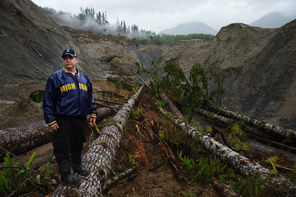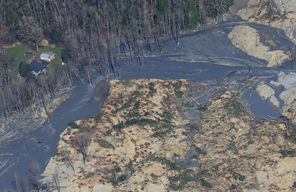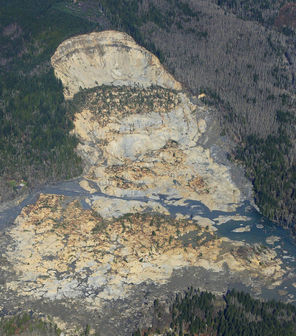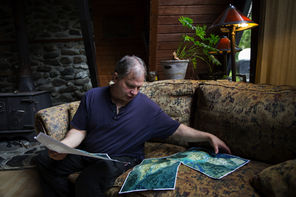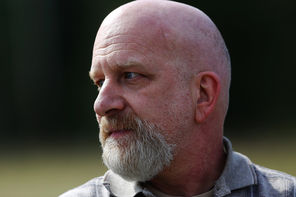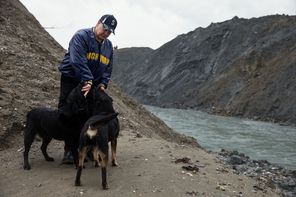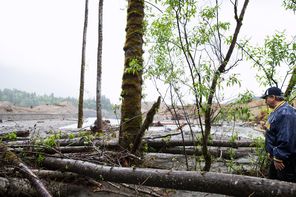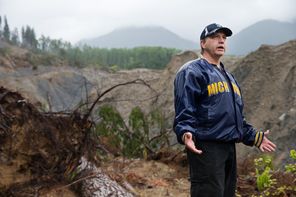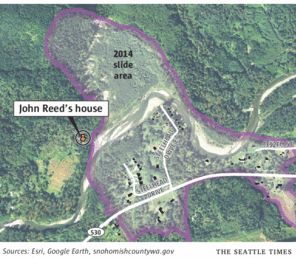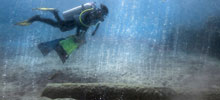Originally published May 27, 2014 at 9:04 PM | Page modified May 28, 2014 at 4:28 PM
Disaster at his doorstep: Oso man faces mudslide’s fallout
John Reed was in his front yard when the Oso mudslide hit, a witness to devastation that came within about 25 feet of his house. Two months later, he’s struggling with the fallout.
Seattle Times staff
MARCUS YAM / The Seattle Times
John Reed, who lives at the edge of the Oso mudslide, stands in the debris field on the bank of the North Fork Stillaguamish River recently.
Ted S. Warren / The Associated Press
John Reed’s house sits at the left edge of the mudslide in this aerial photo taken days after the March 22 disaster, which killed 43 people.
Ted S. Warren / The Associated Press
John Reed’s house is seen near the bottom left of this aerial photo, taken two days after the March 22 mudslide. Reed spent several harrowing nights in his house listening to the earsplitting noise of trees and debris crashing in the river.
MARCUS YAM / The Seattle Times
John Reed, in his living room, studies aerial photos of the Oso mudslide as he explains what he saw from his front yard as the slide went by.
MARCUS YAM / The Seattle Times
John Reed is assessing the damage to his house and property as he continues to live there, next to the mudslide debris field. The river moved a great deal closer: It’s now 25 yards from his house.
MARCUS YAM / The Seattle Times
John Reed, who lives on the western edge of the Oso mudslide, is one of the few eyewitness to the slide coming down. He continues to live next to the debris field.
Oso mudslide: Comprehensive coverage of the March 22 disaster and recovery
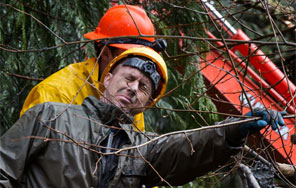
Compiled by The Seattle Times
A collection of stories and visuals about the disaster, why it may have happened and the people it affected.
Interactive map: A detailed view of the neighborhood hit by the mudslide
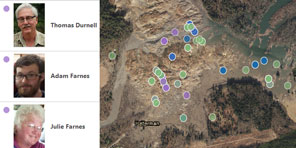
Garland Potts, Cheryl Phillips / The Seattle Times
Use an interactive tool to see the deadly path of the mudslide.
Remembering the victims
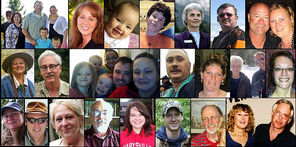
Compiled by The Seattle Times
Read about the lives of the victims who have been confirmed missing or dead by authorities or families.
![]()
OSO — John Reed was in the front yard of his house on the north side of the Stillaguamish River on March 22 when he heard a loud, prolonged scraping and noticed the brief fluttering of treetops on the lower bench of Mount Higgins.
And then it all came down. He and his son Jordan watched the hillside collapse, roar across the river at breakneck speed, snap trees like matchsticks and swallow the Steelhead Drive neighborhood in a tsunami of dirt, trees and debris.
The Oso slide that claimed 43 lives swept past his house, coming within 25 feet or so.
Reed, 51, is among the few surviving eyewitnesses — those with property on the edge of the slide zone — to one of the state’s worst natural disasters.
He’s haunted by what he saw, and the desolation that’s left.
“Picture a big football stadium getting up and running,” Reed said. “You can’t picture that. It doesn’t happen. Mountains just don’t get up and take off, either. But this one did.”
Hillside comes apart
Few people know the area like Reed.
In the 18 years he’s lived on Whitman Road he’s hiked practically every corner of the hillside locals call Whitman Bench, knows where all the natural springs are and is familiar with the quirks of the river. He was drawn here to his three-acre lot by the privacy he enjoys at the end of the road and the tranquil beauty of living on the banks of the “Stilly.”
“The summers are beautiful here,” Reed said. “In September, it’s National Geographic beautiful.”
So when the quiet was broken that March morning by the scraping noise, it caught his attention.
“My son thought it was a 747 about to crash,” Reed said. “It lasted about a minute and a half. It was loud.”
Down the road, another longtime resident, Doug Dix, was working in his barn. Dix also remembers the noise. Loud, like the double-bladed Huey helicopters that occasionally log in the area.
“When they go over your house they make a pressure wave, and I’m feeling that pressure wave, but it sounded like the engine was just shredding,” Dix said. “So my first thought was it was a plane crash or one of those helicopters hauling out a log and he’s going to crash into my barn.”
In retrospect, Reed believes, the noise was the breaking and cracking of a mountain about to come apart.
Reed then noticed the hillside “shimmer and vibrate” for just a few seconds.
“And then — bam! That’s when it all came down. It was moving so fast. And it was turbulent. You could see all the trees twisting and turning and hear them snapping. When those big trees snap, it’s loud.”
Reed says it sounds about right, scientists’ estimate that the slide traveled as fast as 60 mph. At one point, however, he thought the slide slowed, to maybe around 30 mph.
That’s when he remembers a very strange sensation.
“It felt like the ground I was standing on was moving and the slide was standing still,” he said.
But the slide had yet to deliver its deadly punch. When it reached the river, Reed said, it accelerated.
“When it hit the water, it shot way up, way taller than the tallest trees,” Reed said. “Then I saw this big black wall — it must have been more than 100 feet high — rise high above the (Steelhead Drive) neighborhood. The houses, in comparison, looked minuscule. It was unbelievable.
“I’m saying ‘Oh my God. Oh my God.’ ”
That’s when Reed’s view of the Steelhead neighborhood went dark. The moving mountain was now bearing down on his property.
“This mountain of dirt taller than any trees near me cut off my view like a curtain,” he said. “And it shot right in front of me, right by my house. I’m thinking to myself, ‘I better run. It may not be a good idea to be here.’ But I just stood there and looked at it. I thought if it gets too close to me I’ll head up for the hills over there.”
A new landscape
When it ended, the North Fork of the Stillaguamish was blocked just upstream from Reed’s property. The riverbed next to his house soon went dry.
“I’ve listened to that river for almost 20 years,” Reed said. “When it (the slide) stopped, it was dead silent. To not hear the noise of the river was really strange.”
The silence wouldn’t last long. Once the river busted through the dam, the roar returned, only much louder. Reed would spend several harrowing nights in his house amid the earsplitting noise of trees and debris in a river torrent now only a few feet away.
While most of the neighbors followed evacuation orders that first night, Reed chose to stay. He has spent all but one of the nights since the slide in his home, and that was only because the rushing noise of debris was so loud he couldn’t sleep. His wife, Gina, and Jordan no longer feel comfortable there and have moved in with relatives in the area.
“It’s caused a lot of stress,” he said. “And a lot of money and problems.”
While Reed feels fortunate to be alive, the slide didn’t leave him unscathed. The foundation of his home has been damaged. The floor is buckled. A 500-foot section of the narrow, gated dirt road that leads to his home is covered with debris and mud 3 to 4 feet high. His well has also been compromised.
Reed has been given an estimate of $16,000 to fix the road and $11,000 more to cap the broken well and drill a new one. He can’t afford those repairs. He said FEMA has given him $3,400 for damage to the house and $1,500 for the road.
Reed, who does construction work, plans to use most of the money to fix the road and will try to do most of the work himself.
The river has changed, and the surrounding landscape morphs almost daily. He’s seen a lake, whitewater rapids and waterfalls.
Now the river is narrower, swifter, cutting through towering mounds of dirt. The once slow-moving, shallow waters that used to be 100 to 150 yards from his house have carved a deep channel near the edge of his yard, about 25 yards from his house.
Walking through the belly of the slide, gray is the dominant color. The piles of silt, sand, rocks and twisted trees look eerily similar to the aftermath of the 1980 eruption of Mount St. Helens.
Life after the slide
Reed, who also was home during the 2006 slide, has no plans to move. He says he feels safe because the hillside behind him is full of trees — including water-absorbing cedar — and other vegetation.
Reed’s neighbors don’t plan to leave, either, though they’re pretty tired of the gawkers trying to get a peek at the slide.
The Dix home sits about 70 feet above the river. And although portions of his bank in recent weeks have sloughed into the river, Dix and his wife, Kim, aren’t about to leave their idyllic setting and home of more than 30 years.
“We’re high enough that if the river took our house you could pretty much kiss Arlington goodbye,” he said. “My goal is when they put me in the ground, I’ll still be living here.”
Dix’s neighbor across the road, Shelly Dick, also wants to stay.
“It’s unnerving,” she said. “We like it here, and we’re going to stay, but we could never sell our house right now anyway. Everybody’s property values (near the slide) have gone down.”
Reed hopes to use the drier summer to repair the road to his home and fix his well.
“I’m not asking for any more help,” he said. “To be as close to this slide as I was, I’m fortunate my house is still here. I still can’t get over the imagery of what I saw. I replay it in my mind. I feel lucky.”
 Four weeks for 99 cents of unlimited digital access to The Seattle Times. Try it now!
Four weeks for 99 cents of unlimited digital access to The Seattle Times. Try it now!





